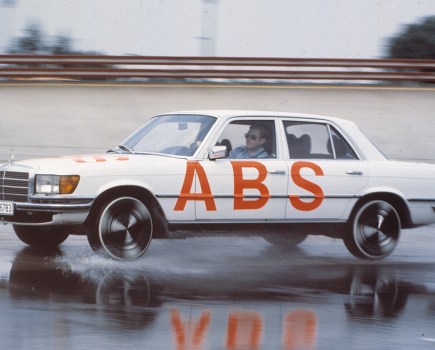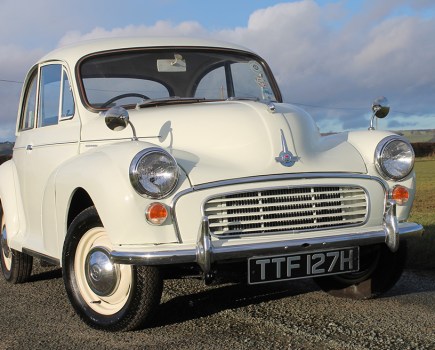Launched in 1959 and originally sold in both Austin and Morris guises, the Austin version was originally going to be called the ‘Newmarket’ in line with the firm’s English town naming theme. Thankfully in the end it was called the Seven, sometimes rendered ‘Se7en’ in early advertising, and the Morris was given Mini-Minor badging – with both adopting the more distinctive ‘Mini’ name in 1969. Despite being so innovative, the start was inauspicious. Initial sales were slow with water leaks and a general wariness of the new technology being used putting buyers off throughout its first few months.
Power came from the A Series engine, which was cutting edge at the time, being just a few years old – the gearbox located underneath, driven by drop gears (hence the Mini’s trademark whine), was accommodated by the Mini’s high bonnet line and allowed the engine to fit within the car’s narrow width. With a capacity of 848cc it developed a spirited 34bhp and due to the fact that the car weighed so little, it always felt nippy. Importantly it was capable of sipping fuel too, usually returning easily in excess of 50mpg.
The adoption of Alex Moulton’s rubber cone suspension, thus doing away with the need for traditional suspension turrets, allowed further space saving. The only real sacrifice of fitting four adults in a 10ft long space was the tiny boot, but we expect owners were so taken with the sheer functionality that they quickly got used to traveling light or making use of the full width front parcel shelf and deep door bins.
Handling, as any Mini owner from this era will testify, was a revelation with its tiny 10-inch wheels, short travel suspension and precise rack-and-pinion steering making it eminently chuckable.
Obviously former Formula One driver John Cooper was impressed because at his suggestion, a ‘hot’ Mini Cooper with a 997cc A Series engine became available from September 1961.
A year earlier estate versions based on the extended floorpan of the Mini van (making it some 10 inches longer than the saloon) were released as the Austin Countryman and Morris Traveller with double swing load doors and stiffer rear springs.
To further enhance the car’s sporting image, in 1963 the first Mini Cooper S appeared, developed by Downton Engineering and boasting a 1071cc variant of the A Series engine.
The first major change to the Mini’s running gear came in 1964 with the adoption of Hydrolastic suspension. At around this time, standard Cooper models receives a tiny capacity increase to 998cc, while the S models were increased to 1275cc, with a 970cc model for homologation purposes.
In the autumn of 1967, the MkII Mini arrived, sporting a revised grille, larger rear window and the option of a 998cc ‘1000’ version with Cooper-style remote gearchange. Further improvements included better brakes and (from 1968) an all synchro ‘box.
The MkIII from 1969 features concealed door hinges, larger doors with winding windows and a return to rubber cone suspension, although the 1275 GT and Clubman would retain the fluid system until June 1971.
Clubman and 1275cc variants with longer bonnets, squared-off front wings and vastly different grilles also arrived in late 1969 and the 850 auto was no more after 1971.
The Mini didn’t receive a great deal of attention in the years that followed, with the MkIV being introduced in 1976 with a rubber-mounted subframe and different rear lights from 1977.
In 1979, the sought after 1098cc ‘1100 Special’ broke cover equipped with alloys and a vinyl roof covering. The 850 was killed off in 1980.
At this time, the range comprised the poverty spec City, with a 42bhp 998cc engine, and the plusher HL, which in turn was replaced by the Mayfair in 1982. This sat alongside the City E, a model designation meant to highlight improvements in economy.
Slowly coming up to date, the MkV appeared in 1984 with 12-inch wheels and disc brakes at the front. The Mayfair used the still very basic looking twin-dial Clubman facia, while incredibly the City E retained the central speedo first used in 1959 – at least for another year when it was replaced by the more conventional dash in 1985.
It was the arrival of the MkVI under Rover management and a raft of special editions that gave the Mini renewed interest from 1990, the highlight of which was unarguably the resurrection of the Cooper fitted with a catalyst-equipped 61bhp version of the Metro 1275cc engine, plus Minilite wheels and contrasting bonnet stripes and roof colours. Just 1000 were built initially from July, with another 650 destined for the Japanese market. They were so popular that the Cooper became a regular production model from September.
An ‘S’ model Cooper was born in 1991 and later the same year single-point fuel injection was adopted to meet emission controls, when they became known as the Cooper 1.3i and Cooper Si.
This was followed by the launch in 1996 of the MkVII with multi-point injection engine, with electronic engine management and electronic ignition (developed under BMW control), complete with a more conventional dashboard, plus driver airbag.
Classic Mini production stopped in October 2000 following the release of various Cooper S and S Works variants and an era comes to a close, although several thousand remained in stock, so it’s not unusual to find one registered following this date.






